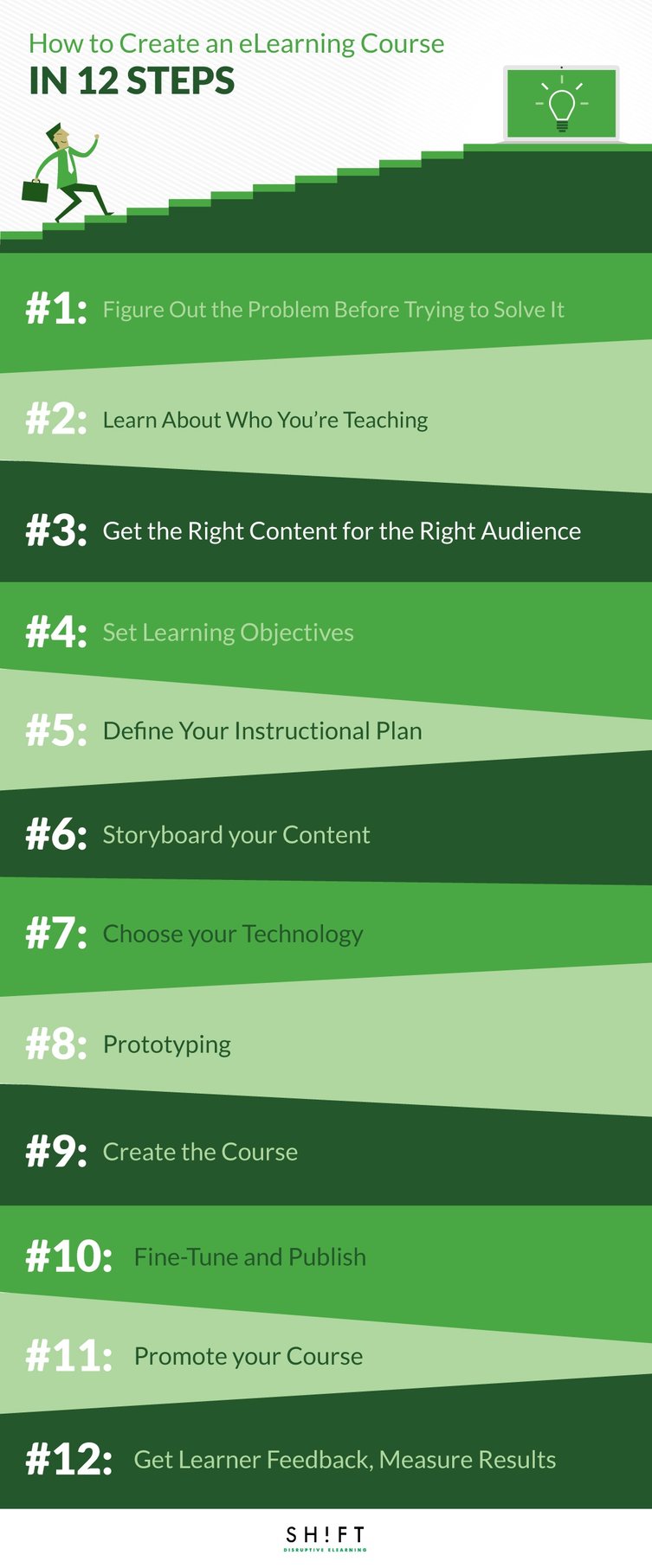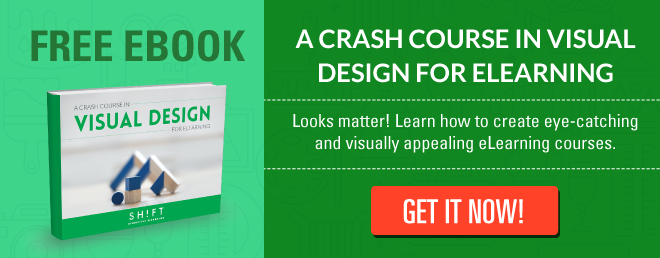Looking at all the things that are involved in creating an eLearning course could make you feel like your first step should be to “Give Up.” However, with these 12 steps, we break down the process into manageable chunks, which is a big part of what makes for a killer eLearning course design. Sounds good, right?
Read through these steps, and soon you’ll have a good handle on what is needed and where to start to create your first eLearning courses.
Step #1 - Start with Why: Do a Need Analysis
Contrary to popular belief, deciding “we need eLearning because everyone else is doing it” is not really the first step to start. Managers add to this problem by expecting things to just get done, or to “just do it.” Many times, they see assessing needs before implementing as a waste of time and value speed in development over all else. Starting an eLearning course based on assumptions is a sure way to fail though.
The first step to creating an eLearning course is, in fact, defining why does your audience need this training? And what it is you want to achieve with this eLearning because otherwise, how will you know if you’ve reached your goal?
A need analysis make sure you aren’t doing training just for training’s sake.
Conducting a needs analysis: This analysis can range from a simple interview to broader, more in-depth data collection methods that include looking at past training, desired results and the current state of your workforce.
The results of this analysis become your plan for design and what you hope to get your learners to achieve because now you know what they actually need, versus just guessing or assuming. It will also show gaps in current training and how you can close the breach and get results.
This also prevents you from throwing eLearning at a problem it can’t solve. Elearning is perfect for addressing gaps in skill or knowledge but is typically not an effective cure for lack of customer satisfaction or a job design problem. By analyzing first, you rule out these other issues and get to the heart of the problem faster than if you have gone on assumption.
Make sure, you’ve ask yourself these questions before continuing to the next step:
- What problem or challenge is this e-Learning going to overcome?
- What do we hope to achieve with eLearning? What outcomes do we expect?
- How will it help the organization or your client meet their business goals?
Read: DON'T Skip the Training Needs Analysis! Here's Why.
Step #2 - Know Your Audience
Writing a course entirely in Spanish to a group of people just beginning to learn Spanish is not an effective way to teach. This might sound like an extreme example of an eLearning designer not knowing their audience, but consider the fact that this is really no different than teaching a beginning javascript course but including advanced terms with no explanation of them.
Designers often go into a project treating their audience with a one-size-fits-all approach in order to get the information out quickly. This, however, ignores your audience’s technical capabilities, existing knowledge, how they will use the knowledge you’re giving them, and their basic demographics.
If a business has low interest in their training programs from employees, it is often the case that the courses are too difficult or too easy, or completely irrelevant to the employees’ jobs. By knowing your audience first and learning what they already know and need to know you can create better, more useful content.
Also Read:
- These 27 Questions Will Help You (Really) Know Your Learners
- The 5 Best Ways to Research Your eLearning Course Target Audience
Step #3 - Do a Content Analysis
Once you’ve determined why training is needed and who your audience is, it’s time to get into the interesting part: CONTENT.
It won’t matter how good your course is designed if the content you are sharing doesn’t have TRUE value for your audience. You need to make sure you gather and/or create the right content for the right audience. This is why this step is so important.
A content analysis is a series of tasks that help eLearning designers to understand what domain the learning objective falls into and how content should be organized accordingly.
During your content analysis, you will:
- Define the skills and actions your learners will need to KNOW and DO after completing the course.
- Work with subject matter experts to outline a clear roadmap of the steps needed to achieve the course's main goal so you can identify the skills/knowledge that are needed in the course.
- Begin to conceptualize an idea of the type of content that will be included at each section of the course:
- Types of content: Fact, concept, process, procedure, principles, interpersonal
- Defining these categories and types also lets us see how the information is interconnected and how important each piece is, what category is most prevalent, what information gaps are, and how information should be arranged.
Step #4 - Define Learning Objectives
Starting out on your eLearning journey without defining the information or skills that you want your learners to obtain by the end is like setting out on a road trip without a destination. While this might make for a neat setup for an indie film about four friends trying to find themselves, this really doesn’t work for eLearning.
So, what is a learning objective? It is an expected outcome of each lesson/unit and, overall, what you want your learners to be capable of by the end of it. They also break down the content from step #3 into more manageable chunks that can be applied to modules within the overall course.
During this step, we, as designers, have the job of asking questions and considering both the desirable and undesirable results of the course. Then we write our objectives based on the final desired results. Start by picking 3-4 objectives. Now make sure your content doesn’t wander too far away from these objectives.
Creating relevant learning objectives can be a big challenge, and before we accept the challenge we have to make sure these are set under the SMART criteria:
- Specific: Make sure you can answer the questions: Who are my learners? What will be accomplished?
- Measurable: Can we measure/observe the progress of the objective? If not, then it doesn’t make a good objective.
- Achievable: Make sure that your goals cannot only be measured but that they can be achieved. This means setting realistic goals for realistic timeframes and available resources.
- Relevant: A good objective must make sense for your target audience. Make sure you know why the objectives are necessary and what their impact will be to ensure they are worth the time and effort.
- Time-sensitive: Can learners accomplish this by the end of the course? If not, then it is not reasonable or worth considering.
Note: Make sure learning objectives are aligned with business objectives
Also read: Do's and Don'ts for writing learning objectives
Step #5 - Define Your Instructional Design Plan
Now is the time to decide on your instructional strategy. This strategy is the process or approach by which your course is going to be developed to engage learners. There are a variety of approaches eLearning designers can take including storytelling, discovery learning, situational learning, and several others.
This infographic guide is a great tool to learn about the primary instructional strategies: Instructional Strategy Infographic
When deciding on a strategy, think about:
- The type of content: How can I best teach a fact versus a concept? A procedure versus an interpersonal skill?
- Impact: What is the best way to make this training meaningful and relevant?
- Objectives: How can I ensure each trainee will master the objective?
Learn the differences between strategies and models here: Models Vs. Strategies Infographic
Step #6 - Storyboard Your Content
A storyboard is a rough, visual outline that helps map out how text, pictures, and other elements will look on a page. This will help you see how your page will look before you waste time putting together the final design only to find out the elements don’t fit together right.
However, before you start in the design phase, make sure your content has been approved. There’s no reason to include content in your planning if your client or team leaders might end up telling you not to use it.
Step #7 - Choose Your Technology
When determining what authoring tools and learning management systems you should use, look at reviews from other designers, available features, cost, and what is best for your organization. There is not one tool that works for everybody. Needs vary from one company to another.
Also, look at these aspects to get yourself thinking about what’s right for your company:
- How many people will be accessing the program at one time? The average? The max?
- Will the course be accessed on the company’s devices or will each learner be using their own?
- Are there required applications to be installed?
- Does your company have enough bandwidth to run the courses?
- What is your plan for backing up information and security?
- How will you maintain your server?
- What kind of support system will you offer end users?
Step #8 - Prototyping
Now, it’s time to build a working, prototype of a module from your course to make sure it actually works. A prototype defines the representative look and feel and functionality of the entire course. It also is used to test out technical functionality. This allows eLearning designers to create and discard multiple versions quickly to get the best fit before wasting too many resources on designing the whole course and then finding out something doesn’t work.
Note: Get approval for the prototype from the project leader before going for the whole course.
Read: Instructional Design for the Greater Good: Developing a Prototype
Step #9 - Create the Entire Course
Once you have your prototype approved, it’s time to start designing the actual course. During this process you need to keep an eye on the original objectives and problems to ensure the course, as a whole, is geared towards solving these.
You also need to determine a design method that meets the needs of learners. Professional eLearning designers use different models.
Some of the most popular are: ADDIE/SAM, Gagne's 9 Principles, and Action Mapping among others.
Learn the 4 Top Instructional Models here.
Applying Gagné's 9 Events Of Instruction In eLearning
Step #10 - Fine Tune and Publish
Take feedback and comments from your team (and clients), make corrections as needed, then publish!
Step #11 - Promote Your Course (Internally or Externally)
Why do your learners need your course? How will they find it? You know that your course can help them, but now they need to know about it! It’s time to promote and market. To do this, focus on the benefits to your learners to get them invested in the learning journey.
Promotion should be part of your development plan, and your very first slide should engage your audience from the start. Creating an internal promotion plan will save you the heartache of creating an awesome course only to find out nobody is taking it.
Step #12 - Ensure You Can Measure and Evaluate the Results
Determine how effective your course has been by asking your learners. This will help you figure out what you did right and what you can improve on in the future. To determine if this has been achieved, many use Kirkpatrick’s Four Levels of Evaluation.
You will also look at such factors as return on investment, cost, and performance. To get the best idea of your key performance indicators, you should involve the management team and stakeholders.
REFERENCES:
https://www.mylearningspace.com.au/news/6-steps-to-an-effective-learning-strategy/
https://www.fao.org/docrep/015/i2516e/i2516e.pdf
http://www.tacso.org/doc/doc_manual9.pdf
https://training.fws.gov/courses/references/job-aids/trainers/HOWTO-create-online-course.pdf




